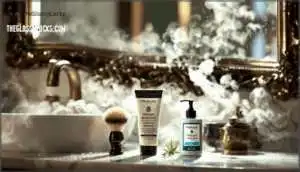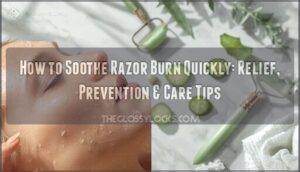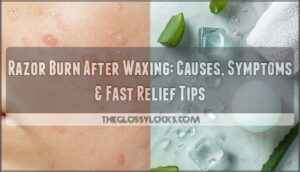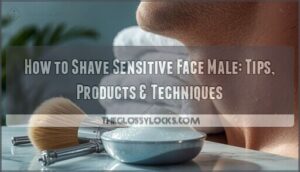This site is supported by our readers. We may earn a commission, at no cost to you, if you purchase through links.

A proper shave routine isn’t about adding complexity; it’s about understanding how preparation, technique, and aftercare work together to protect your skin while delivering clean results. When you know which steps actually matter and which tools earn their keep, you’ll transform a daily chore into a ritual that leaves your face smooth, healthy, and ready to face whatever comes next.
Table Of Contents
Key Takeaways
- Proper prep work—warm water soaking, exfoliation, and pre-shave oil—softens whiskers and opens pores, cutting irritation before your blade ever touches skin.
- Sharp blades replaced every 5-10 shaves and shaving with the grain first prevent razor burn, ingrown hairs, and skin damage that dull or misused razors cause.
- Quality tools matter: safety razors reduce irritation by 20% compared to cartridge razors, while rich lather from proper cream and brush technique creates the protective barrier your skin needs.
- Post-shave care—cold water rinse to close pores, followed by soothing balm and proper razor cleaning—stops razor burn and bacterial buildup that ruin an otherwise solid shave.
How to Prepare Skin for Shaving
The best shave doesn’t start with the razor—it starts with how you treat your skin beforehand. Skipping prep is like trying to cut through thick brush with a dull blade: you’ll get resistance, irritation, and lousy results.
Here’s how to set yourself up for a clean, comfortable shave every time.
Cleansing and Hydrating The Skin
Before your razor ever touches skin, mastering the fundamentals of cleansing and hydration can mean the difference between a smooth shave and a face full of irritation. Start by cleansing your face with warm water to strip away oil, sweat, and grime that throw off your skin pH balance.
Let your skin soak for three minutes—whether in a warm bath or using facial steaming—to hydrate properly and soften whiskers. This skin preparation opens pores and prepares everything for what’s coming next.
Exfoliation Techniques for a Smoother Shave
Dead skin cells are sitting on your face right now, creating a barrier that dulls your blade and invites razor burn—so exfoliation isn’t optional if you want a truly smooth shave.
Exfoliation removes dead skin cells that dull your blade and cause razor burn—skip it and sacrifice a smooth shave
Use a gentle scrub or skin brush 30 minutes before shaving to remove dead skin cells and lift hairs. Sugar scrubs work well for sensitive skin, while chemical peels and microdermabrasion offer deeper exfoliation for tougher skin preparation needs.
Using Pre-Shave Oils and Moisturizers
Once you’ve scrubbed away the old skin, pre-shave oil becomes your blade’s best friend, creating a slick protective barrier that softens whiskers and helps your razor glide without dragging or irritation. Look for oils with natural ingredients like jojoba or grapeseed—skip menthol in sensitive areas. Follow with a light moisturizer to lock in skin hydration before lathering up.
Pre-shave benefits you can’t ignore:
- Protection layer: Oil shields your skin from blade friction and reduces razor burn risk
- Whisker softening: Natural oils penetrate hair follicles, making coarse hair easier to cut
- Moisture retention: Hydrated skin resists nicks and heals faster after shaving
- Enhanced glide: Slick surface lets your razor move smoothly without tugging or catching
Trimming and Softening Hair Before Shaving
If your beard’s grown past stubble length, don’t go straight in with a razor—trimming down to a short, even stubble first saves your blade from clogging and prevents painful tugging that leads to irritation.
Use clippers or scissors to cut hair close before applying preshave oil, which penetrates the follicle to soften coarse hair texture.
Warm water soaking for three minutes boosts shave readiness by hydrating strands along the hair growth direction, making them yield easily to your blade.
Choosing The Right Shaving Tools
Your shave is only as good as the tools you use. The right razor, blade, and lather can mean the difference between a clean, confident result and a face full of irritation.
Let’s break down what actually works.
Selecting The Best Razor for Your Skin Type
Choosing the right razor isn’t about following trends—it’s about knowing your skin. Safety razors cut erythema by nearly 20% compared to cartridge razors, making them ideal for sensitive or reactive skin types.
Single-blade designs minimize razor burn and ingrown hairs, while razors with moisturizing strips suit dry skin. Match blade angles and razor materials to your shaving frequency and skin’s needs, and you’ll master shaving techniques that deliver comfort, not irritation.
For best results, consider using sensitive skin razors that cater to specific skin types.
Importance of Sharp and Clean Blades
A dull blade doesn’t just give you a rough shave—it’s a one-way ticket to irritation, nicks, and ingrown hairs that’ll have you regretting every stroke. Sharp edges slice through hair cleanly, while dull ones tug and tear. Blade replacement every 5-10 shaves keeps your razor performing at its peak.
Proper razor maintenance means rinsing blades with hot water after every couple swipes and storing them dry to prevent rust—clean shaving starts with blade care you won’t skip.
Recommended Shaving Creams, Gels, and Brushes
Your shaving cream, shaving gel, and shave brush form the core of your grooming arsenal—choose wisely and your skin will thank you. Premium options deliver protection, hydration, and that rich lather traditional shaving soap demands.
When selecting a shaving product, consider the benefits of using shaving creams for a smoother shave.
- Shaving Cream Types: Proraso Sensitive (oatmeal and green tea) or Vanicream (fragrance-free) tackle irritation head-on.
- Gel Formulations: Post-foaming gels soften hair faster than standard creams, cutting razor burn risk.
- Brush Materials: Badger hair holds water like a champ; synthetic rivals match performance at lower cost.
- Skin Soothers: Aftershave products with aloe or witch hazel calm and seal freshly shaved skin.
Effective Shaving Techniques for Better Results
You’ve got the tools and your skin is prepped—now it’s time to master the technique. The way you manage your razor makes all the difference between a rough, irritated shave and one that leaves your skin smooth and comfortable.
Let’s break down the key moves that separate a rushed job from a proper shave.
Shaving With The Grain Vs. Against The Grain
The direction you shave—with the grain or against it—makes all the difference between a clean, comfortable shave and a face full of irritation. Always start by shaving with the grain, following your hair follicles’ natural direction. This shaving technique minimizes razor burn and keeps skin tension balanced.
If you’re chasing a closer shave, make a second pass—lather up again and carefully shave against the grain. Just remember: that razor glide needs to be controlled, or you’ll pay for it later.
Building and Applying a Rich Lather
If you want that perfect shave, you need to master the lather—it’s the protective cushion that stands between your razor and your skin.
Wet your shaving brush thoroughly, then work it into your shaving soap using firm circular motions. Build that lather until it’s rich and thick, not runny.
Apply it in upward strokes to lift the hairs and create the ideal barrier for your blade.
Maintaining Proper Pressure and Stroke Direction
Pressing too hard with your razor is like forcing a dull knife through a steak—you’ll end up with a mess instead of a clean cut. Let the blade do the work.
Use small, gentle strokes and maintain a 30-degree razor angle against your skin. Shave with the grain first—follow your hair’s natural direction to prevent razor burn and irritation.
Keep your skin taut and focus on glide technique, not pressure points. Your shaving routine should feel controlled, not forced.
Tips for Sensitive or Problem Areas
Some spots on your face and body demand extra finesse—especially the neck, jawline, and anywhere your skin is prone to flare up. Here’s how to manage sensitive skin without triggering razor bumps or ingrown hairs:
- Reduce passes—one careful stroke beats multiple aggressive ones for redness relief and preventing skin irritation.
- Rinse constantly—keep your blade clean to minimize friction and razor burn on problem zones.
- Skip against-the-grain shaving—stick with hair direction in sensitive areas to avoid inflammation.
Essential Post-Shave Skin Care
What you do after the razor leaves your skin matters just as much as the shave itself. The right post-shave routine keeps your skin calm, protected, and ready to face whatever comes next.
Here’s how to lock in that fresh feeling and avoid the common pitfalls that ruin an otherwise solid shave.
Rinsing and Cooling The Skin
Once the blade’s done its work, what comes next can make or break your entire shave—so let’s talk about cooling down the right way.
Rinse with cold water immediately to tighten skin and close pores—it’s the supreme cold water therapy for postshave skin care. This simple soothing technique stops razor burn before it starts, minimizes pore size, and calms any irritation. Don’t skip this step if you want control over your results.
Preventing Razor Burn and Ingrown Hairs
Razor burn and ingrown hairs are preventable when you follow proven shaving techniques and exfoliate regularly—shaving with the grain cuts your risk of ingrown hairs by roughly 60%.
Replace blades every 5–7 shaves to prevent irritation spikes of 35%, and never press hard on the razor.
Spot-treat problem areas with antibacterial ointment to lower infection risk by 30%, and keep shave frequency sensible—your hair follicles need recovery time between sessions.
Razor Cleaning and Storage for Skin Health
Your razor collects bacteria, dead skin, and soap scum with every stroke—so keeping it clean isn’t optional if you want smooth skin instead of breakouts. Rinse blades with hot water after every two strokes, then dry completely to prevent rust and bacterial buildup. Store your razor in a dry, ventilated space—never in a damp shower caddy.
Razor blade maintenance checklist:
- Sanitize with rubbing alcohol weekly to eliminate hidden bacteria
- Replace blades every 5–10 shaves to avoid razor burn and razor bumps
- Rinse under hot water immediately after shaving to remove residue
- Store upright in a protective case away from moisture
Frequently Asked Questions (FAQs)
How often should I replace my razor blade?
Think of blade replacement as the difference between a clean break and a dull tear. Replace your razor blade every 5-10 shaves to maintain blade sharpness and prevent irritation.
Blade durability depends on shave frequency and proper razor maintenance—rinse, dry, and store correctly to extend blade replacement intervals.
What causes razor burn and how to prevent it?
Razor burn causes include dull blades, dry shaving, and excessive pressure on skin.
Preventing razor burn and ingrown hairs requires proper shave preparation—warm water, exfoliation, and quality cream.
Post shave care with cold water and soothing balm stops skin irritation fast.
Should I shave before or after a shower?
Shave after a shower. Warm water softens hair and opens pores, making skin preparation for shaving easier.
This shave sequence helps you exfoliate naturally and prepares your shaving routine for cleaner, smoother results with fewer nicks.
Can I use the same razor for different body areas?
It’s tempting to think one blade fits all, but sharing your razor across body areas is like using the same towel for your face and feet—risky business.
Cross contamination and skin irritation increase when you move from coarser zones to sensitive ones without proper razor sanitizing or blade replacement.
Whats the best way to treat ingrown hairs?
Ingrown hairs happen when hair follicles curl back into the skin, causing skin inflammation and redness.
Stop shaving the affected area immediately and apply a warm compress to reduce swelling and bump prevention while dealing with ingrown hairs naturally.
Conclusion
Every face you’ve ever admired—sharp jawline, clear skin, zero irritation—didn’t happen by accident. Those results come from understanding how to improve shave routine fundamentals: prep work that softens resistance, tools that respect your skin’s limits, and aftercare that heals instead of punishes.
You’ve got the blueprint now. Stop settling for the bare minimum and start treating your face like it matters. When you show up with intention, your skin will reward you with results worth looking at twice.
- https://thecutbuddy.com/blogs/news/the-importance-of-pre-shave-preparation-steps-for-a-better-shave
- https://www.nakedarmor.com/blogs/grown-man-shave-society-articles/the-pre-shave-ritual-101
- https://www.mdedge.com/cutis/article/259962/hair-nails/new-razor-technology-improves-appearance-and-quality-life-men/page/0/3
- https://pmc.ncbi.nlm.nih.gov/articles/PMC10818121/
- https://www.news.market.us/shaving-statistics/








